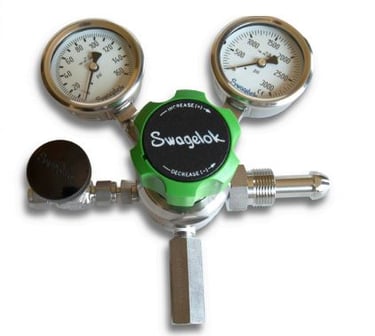 Regulators may appear simple from the outside, but a small change in that block of steel may result in a total system failure or a potentially hazardous condition. The use of off-the-shelf regulators followed by the failure to improve their corrosion resistance could possibly trigger a regulator failure. The best way to avoid this is to opt for customized regulator assembly with excellent accuracy, sensitivity, and setpoint pressure stability. The importance of customization can be best realized by analyzing risks associated with the wrong pressure regulator set up on a healthy flow system.
Regulators may appear simple from the outside, but a small change in that block of steel may result in a total system failure or a potentially hazardous condition. The use of off-the-shelf regulators followed by the failure to improve their corrosion resistance could possibly trigger a regulator failure. The best way to avoid this is to opt for customized regulator assembly with excellent accuracy, sensitivity, and setpoint pressure stability. The importance of customization can be best realized by analyzing risks associated with the wrong pressure regulator set up on a healthy flow system. Gas pressure regulators have a sensing element that balances between internal forces (i/p or o/p pressure) and loading forces. Even a slight change to downstream or upstream may require operating the regulator under a new set of conditions. It’s imperative to recalculate the flow curve to cross-check the compatibility of existing regulators under new conditions, as it might turn your regulator to be undersized or oversized. On one hand, if it is undersized, it will open as much as possible to increase the flow rate, thereby speeding up erosion. On the other hand, oversizing will increase downstream pressure spikes as the poppet and seat will allow too much flow. In short, a minute change to your system may require you to recalibrate regulators as well as their associated components such as filters, flanges, and gauges for any possibility of replacement or modification.
To avoid or troubleshoot these issues, it’s best to have a customized gas regulator assembly based on your specific needs.
Have the following in mind when selecting a gas regulator assembly:
Identify two key elements to size up your regulator:
You may also require the following data for a close match:
Once you have the correct data, look for the regulator that matches your requirement.
It is also necessary to check the flow curve of a regulator. Flow curve determines the ideal condition of operation for a regulator. Any flow curve can be divided into three areas: lockup, flat flow, and droop. When you operate a regulator in its lockup or droop zone, it faces a hard time maintaining accurate pressure. Therefore, make sure your preset operative conditions are lying in the flat zone of the regulator to promise better performance. If the numbers align to the extreme right (droop zone) or extreme left (lockup zone), look for a better-suited regulator model.
For better pressure resolution and pressure control, the maximum inlet pressure of the regulator should be close to your system's related pressure. For example, if your maximum inlet pressure is 400 psig, a 500-psig regulator will do better than a regulator of double or triple capacity. Also, make sure that your desired outlet pressure lies close to the midpoint of the regulator's pressure control range. That means a system with 120 psig as desired outlet pressure will go well with a 0-250 psig control range.
It is imperative to keep every small variable in check to determine a regulator's compatibility with the system. For instance, most flow curves are based on air or nitrogen flow (for gas service) or water flow (for liquid service) in the regulator. If your system carries a gas denser than air or nitrogen, you need to apply a correction factor to calibrate the flow curve again. Be careful to not use a regulator above its official limit.
Swagelok Northern California offers you a variety of configurations when it comes to customizing your inline as well as gas regulator assembly. Our Field Engineers can customize our KPR Series regulators with more than 2 million configurations to meet your specific needs. However, if you're looking for a small range of parameters, we encourage you to download our brochure and build an assembly ordering number with the following five simple inputs:
You can order additional options and configurations by getting in touch with our Field Engineers.
The table below shows our available regulator assembly types for various pressure ranges.
| Control Range (psig) | Maximum Inlet Pressure (psig) | Flow coefficient (Cv) |
| Gas Bottle Regulator Assembly | ||
| 0-500 | 3600 | 0.06 |
| Inline Regulator Assembly | ||
| 0-10 | 100 | 0.06 |
| 0-25/50/100 | 500 | 0.06 |
| 0-250 | 1000 | 0.20 |
It is natural to come across a lot of doubts while looking for a customized solution for a specific application. Taking advice from a local expert with global expertise would be the ideal first step, and that's where Swagelok's expert Field Engineers come into the picture. Let us help you understand your specific needs to design, build, or recommend the most effective gas regulator assembly suitable for your applications.
To find out more about how Swagelok Northern California can help you with selecting a custom gas regulator assembly for your industrial needs, contact our team today by calling 510-933-6200.
About Swagelok Northern California
Swagelok Northern California is a locally owned sales and service center of Swagelok, a $2 billion privately held developer of fluid system products, assemblies, and services for the oil and gas, chemical and petrochemical, semiconductor, and transportation industries. We have locations in Fremont and Concord, CA (USA). Phone: 510-933-6200.
—
Copyright © 2011-2024 Swagelok Northern California. All Rights Reserved.